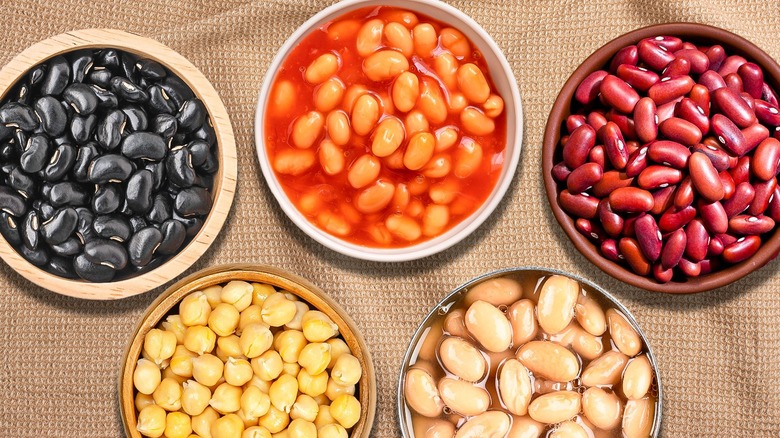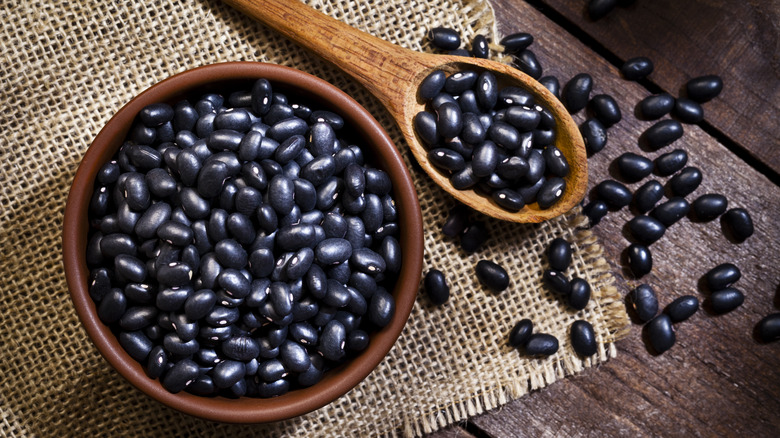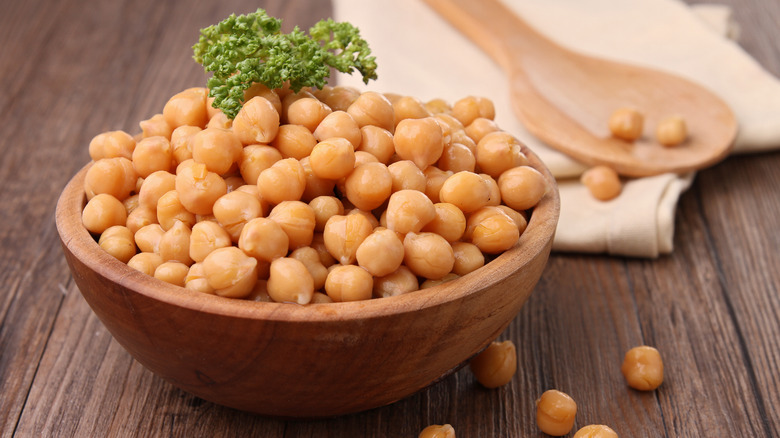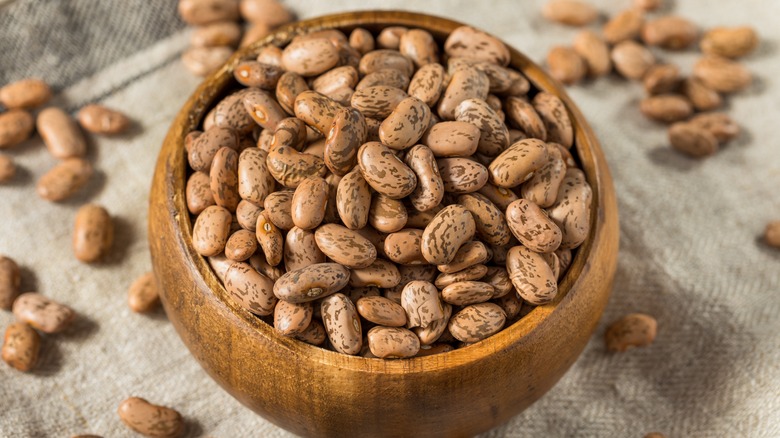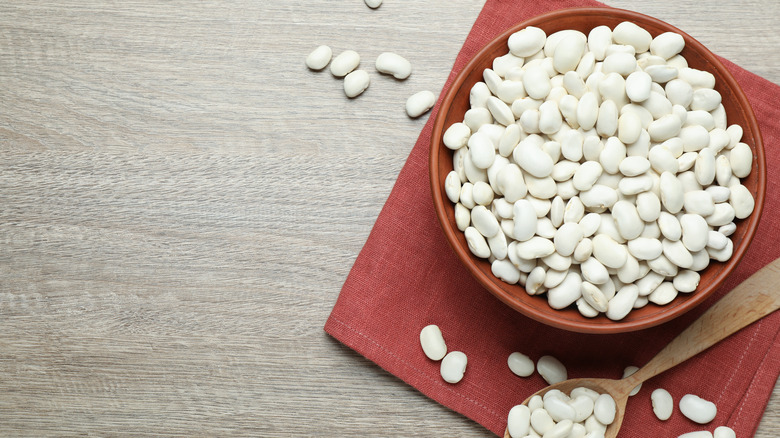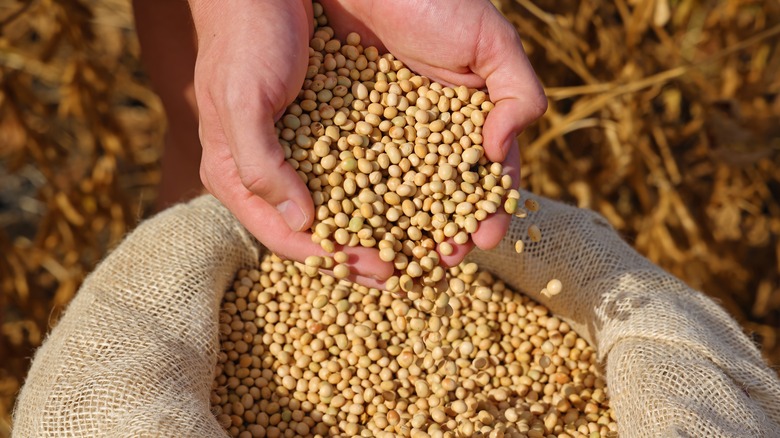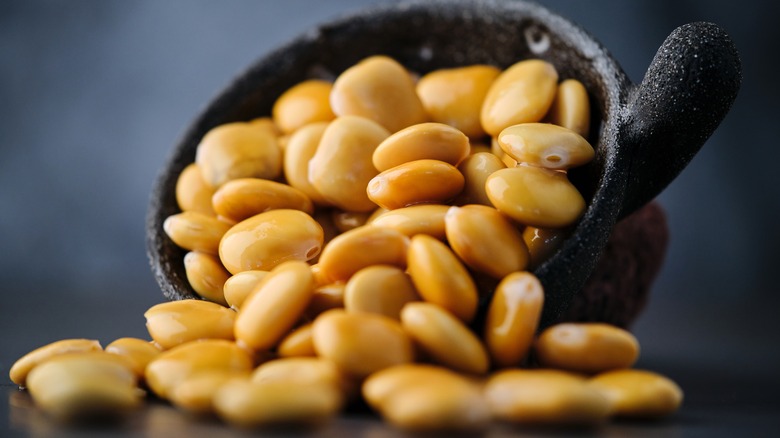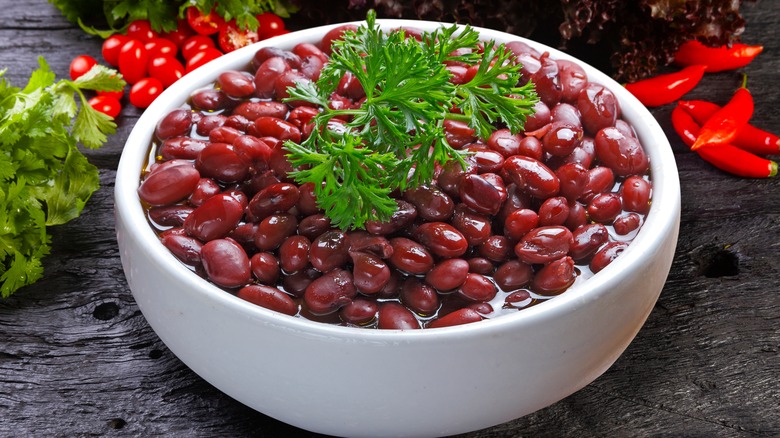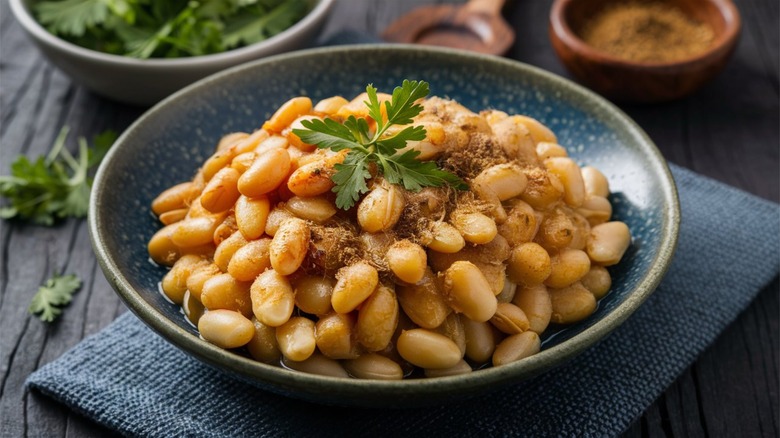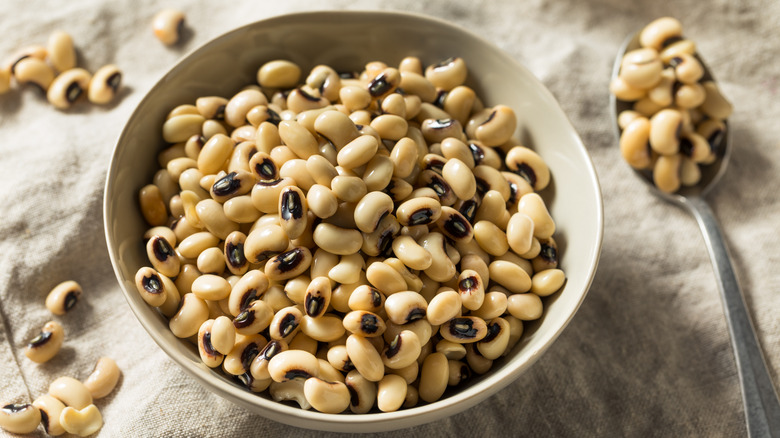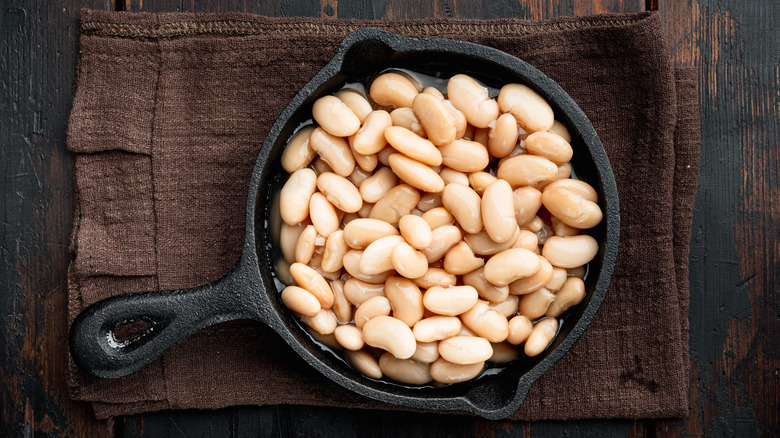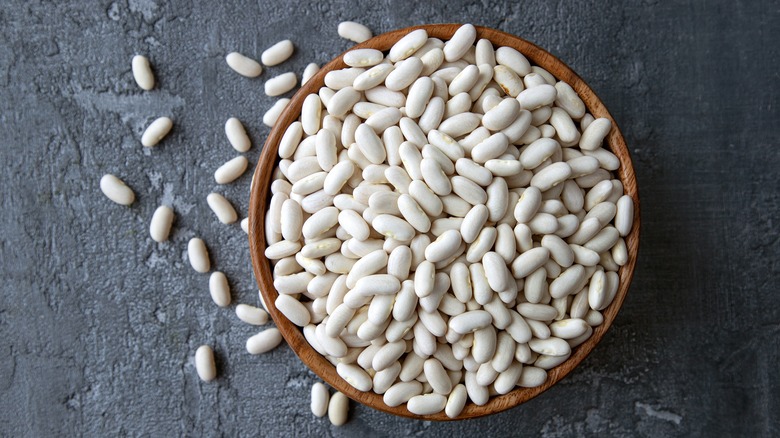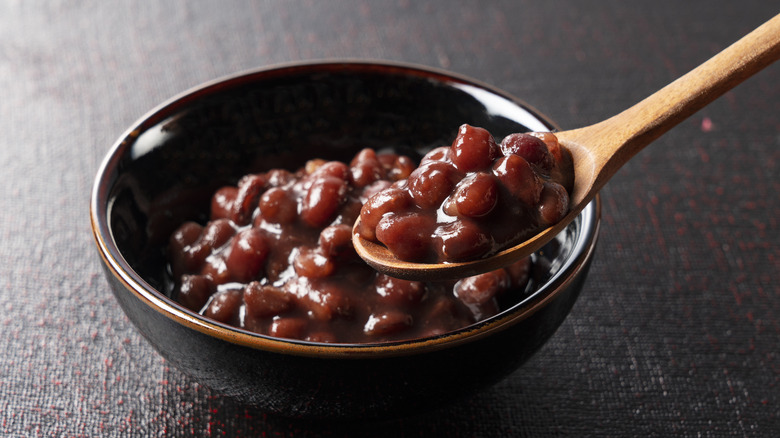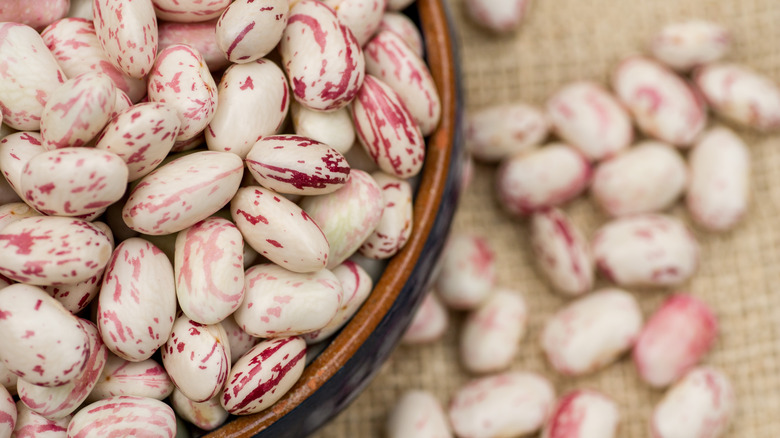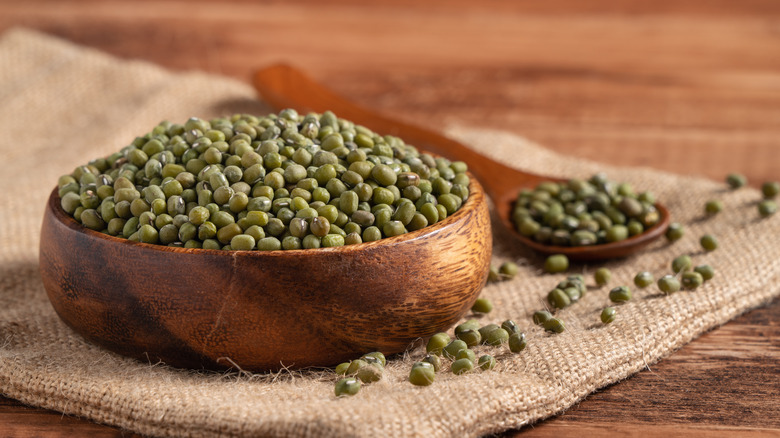14 Healthiest Beans You Should Always Keep In The Pantry
Beans are an excellent source of plant-based protein, making them a perfect addition to many recipes, from tacos and chili to pasta dishes and bruschetta. In their canned form, they're quick and convenient to use, while dried alternatives are ridiculously cheap and arguably tastier when cooked well. Because they're shelf-stable, they're great for keeping in your pantry — and you might be wondering which are the healthiest ones.
The fact is most types of beans are healthy. They're all high in protein and fiber, and they contain various vitamins and minerals. So you can't go wrong with whatever beans you choose. That said, more highly processed canned beans — such as baked beans, franks and beans, or refried beans — are higher in salt and sugar, so they're not quite as good for you as straight-up beans. If you're looking for something healthy, these are 14 types of beans you should always keep in the pantry. We'll look more closely at their nutritional value and some of the best ways to use them.
Black beans
When it comes to black beans, you get 15 grams each of protein and fiber in every cup. They're also rich in folate, copper, and iron, among other vitamins and minerals. Folate is important for fetal development, so black beans are a great ingredient to incorporate into your diet if you're pregnant. Because they're packed full of antioxidants, they may lower the risk of various conditions, including heart disease, type 2 diabetes, and cancer.
Convinced enough that you want to start eating more of these beans? Here are some of the great ways you can use them. Black beans are among the many types of beans that are great to use in chili, but naturally, they're much more versatile than that. You can make your own homemade refried beans with them, which helps you control the amount of salt and the types of fat compared to store-bought varieties. They taste good in tacos and burritos or simply tossed through a salad straight out of the can.
Chickpeas
Chickpeas — or garbanzo beans — are popular enough that most people have a can or two somewhere in their pantry. And the good news is they're extremely healthy. A cup of cooked chickpeas contains slightly less protein and fiber than the same quantity of black beans — 14.5 grams and 12.5 grams, respectively — but still a good amount. They contain all but one of the essential amino acids (lacking just methionine), so some consider them a higher-quality protein than other legumes. However, there's really no need to consume all the amino acids in one food or meal, as long as it balances out over the week or month.
Because chickpeas have a low glycemic index and plenty of fiber and protein, they can help regulate blood sugar after eating. This is not only good for people with diabetes but anyone who experiences a slump a few hours after eating. They're also great for your digestive system, as they contain mostly soluble fiber, which helps increase the beneficial bacteria in your gut.
You can eat chickpeas in many ways. Hummus is perhaps the best-known chickpea dish out there, but you can go far beyond that. Roasting canned chickpeas makes a delicious snack. They're super tasty in soups and stews, and you can add them to a range of pasta dishes. Mashed and mixed with mayo, they're great in sandwiches or on salads.
Pinto beans
With 16 grams of fiber and 16 grams of protein in a cup of cooked pinto beans, they're among the healthiest legumes. They contain roughly 20% of the iron, magnesium, phosphorus, and potassium that you need each day. They also contain lesser quantities of other vitamins and minerals, including calcium and some B-vitamins. The high fiber is good for gut health, heart health, blood sugar control, and more. Like all beans, they contain antioxidants, but pinto beans are especially high in kaempferol, which has been linked to a lesser risk of cancer in some trials.
Pinto beans are often used to make refried beans, but there are far more recipes you can make with them. They're great in soups and stews, BBQ beans, burritos, and chilis. You can blend them into dips or mash them and eat them on toast. With so many options, incorporating more pinto beans into your diet is easy.
Navy beans
Navy beans are sometimes also called haricot beans, and they're a perfect choice for anyone looking to up their fiber intake, as there's more than 19 grams in one cooked cup of these legumes. There's also 15 grams of protein and 32% of the potassium you need in a day. Plus, they contain smaller quantities of calcium, magnesium, iron, folate, and more.
With large quantities of both soluble and insoluble fiber, navy beans are beneficial for regular bowel movements and overall digestive health. They're also high in resistant starch, which tends to cause less bloating than other forms of fiber. The iron and copper in the beans can also play a part in healthy circulation.
You've probably eaten navy beans in the form of baked beans, as these are the beans commonly used to make them. At home, you could use canned or dried haricots to make healthier baked beans, without excessive sugars, salt, and additives. These beans are also perfect in stews and casseroles, pasta dishes, dips, and many other recipes.
Soybeans
Some of the most protein-rich beans around, a cup of cooked dried soybeans contains more than 28 grams of the necessary nutrient. This amount of soybeans also contains 10 grams of fiber and notable quantities of calcium, phosphorus, potassium, and magnesium. Like other beans, they're beneficial to digestive health due to the fiber content, among other things.
Soybeans are sometimes given a bad rap because they contain isoflavones, which are phytonutrients belonging to a group of substances known as phytoestrogens. They resemble estrogen in some ways, and this has led many people to believe they disrupt your hormone balance. This misinformation comes from a paper published way back in the 1970s, which has now been discredited. In fact, recent research suggests phytoestrogens have a range of health benefits, including decreasing the risk of breast and prostate cancers, reducing the unpleasant symptoms of menopause, and improving bone density.
Soybeans generally aren't sold canned — though you may occasionally find them in this form in specialty shops. The fresh version is more commonly sold frozen as edamame beans. These are great in various dishes, including salads and stir fries, and eaten lightly salted straight out of the pod. You can also buy them dried and cook them. Traditionally, soybeans are used to make soymilk and tofu — which you can turn your hand to at home. They're also great anywhere you might use other white beans, such as in dips and soups. Another great way to use them is in a Korean dish called kongjang, where you braise them in sesame sauce.
Lupini beans
If you're looking for a protein-rich bean, lupini beans — also known as lupins — should definitely be on your list. A cup of them, cooked, contains 26 grams of protein, which is up there on the league table. They contain less fiber than most beans, though, at around 5 grams for every cup of cooked beans. That said, this could be a good thing if you find beans make you gassy, as the fiber content contributes to this. They also contain plenty of zinc, copper, magnesium, potassium, folate, and more.
Since lupini beans aren't the most common of legumes, you probably won't find them in cans on supermarket shelves. Rather, you can buy them dried or occasionally in jars from health food stores and other specialty sellers. They come in bitter and sweet varieties — and you'll probably want to get the sweet ones since the other needs to be soaked and boiled over several days not only to improve the flavor but to remove toxins. They're most commonly found in Mediterranean cooking, but you can use them in most recipes that call for other white beans.
Kidney beans
Per cooked cup, kidney beans give you about 14 grams of both protein and fiber. That's a good balance if you want plenty of both in your beans. Beyond this, they contain various vitamins and minerals, including potassium, calcium, iron, and folate. Thanks to their high fiber content, kidney beans may help lower cholesterol levels, reducing the risk of heart disease. They're also pretty low on the glycemic index, which aids in managing blood sugar levels. Rich in antioxidants, kidney beans can also generally reduce inflammation in the body. So, they might be fairly basic in the legume world, but kidney beans are worth paying attention to.
When it comes to cooking with these guys, there are so many things you can do with canned beans, and it's super simple to throw a can of kidney beans into a chili or burrito. They're also common in some Indian and Caribbean curries and in staples like rice and beans. What's more, you could mash them and turn them into a veggie burger or bean balls. Of course, you can also buy them dried and cook them from scratch. Overall, they're a reliable, versatile, and healthy choice for keeping in your pantry.
Lima beans
Like all beans, lima beans are rich in fiber and protein. They contain around 12 grams of protein and 9 grams of fiber per cup of cooked beans. But that's not where the benefits stop. Lima beans contain an impressive 92% of the manganese you should consume in a day — this mineral is essential for bone formation, blood clotting, and reducing inflammation. They're also an excellent source of iron, copper, magnesium, and potassium. They contain more vitamins than most other beans, including 19% of the vitamin C and vitamin B6 you need daily. As we've touched on with other beans, their fiber content promotes digestive health and helps keep blood sugar levels stable through the day. They also have antioxidants called polyphenols that are good for cholesterol levels and heart health.
You can find lima beans both canned and dried. They're sometimes called butter beans in their larger, white form or lima beans when they're smaller and green. They work well in soups, stews, dips, spreads, and so much more. You can chuck these legumes into a salad to make it more filling. They're also great in pasta dishes and various other Mediterranean recipes.
Black-eyed peas
While their name might suggest otherwise, black-eyed peas are actually beans. A single cup (cooked) gives you 13 grams of protein and 11 grams of fiber. Their overall nutrient profile is impressive too. In each cup, you get 88% of the daily value of folate, 50% of copper, 28% of thiamine, 23% of iron, 21% each of magnesium and phosphorus, and 20% of zinc. They're also rich in antioxidants called polyphenols, and like other legumes, they can play a part in maintaining heart health.
Black-eyed peas are a Southern New Year's tradition, but their uses go far beyond that. You can use them in bean burgers, tacos, salads, soups, and so many more dishes. They work with bold flavors like cumin, chilies, and smoked paprika, and well as more subtle flavors, such as parsley and dill. They're versatile to use interchangeably with basically any other bean, whether white, red, or black.
Cannellini beans
You get a solid mid-range amount of both protein and fiber in cannellini beans — also known as white kidney beans. In a cooked cup, they contain about 16 grams of protein and 10 grams of fiber. These beans are also rich in other essential nutrients, provide plenty of iron and calcium, and have a decent amount of magnesium, potassium, and folate. Importantly, they can help reduce blood pressure, which is crucial for your heart and reducing your risk of stroke. They're also good at balancing blood sugar levels to avoid spikes and crashes. What's more, the polyphenols in cannellini beans are powerful antioxidants and can reduce the chance of cancer, heart disease, and certain infections.
You can find plenty of tasty ways to enjoy cannellini beans. They're great in dips, soups, and stews, bringing their creamy texture into play. A favorite in Italy, they're commonly used on bruschettas and white bean pizzas, as well as in pasta dishes. If you have a recipe that calls for another white bean, cannellinis will do the trick here, and they're readily available both canned and dried.
Great northern beans
Also simply known as northern beans, great northern beans have around 16 grams of protein and 14 grams of fiber per cooked cup. They also contain around 50% of the folate and manganese you need in a day — plus slightly over 30% of the daily value of phosphorus. On top of this, they offer lesser amounts of other vitamins and minerals, including zinc, selenium, calcium, and vitamin B6. It seems that eating legumes, including great northern beans, has been linked with a lower risk of mortality from all causes in some studies, like one published in the journal Foods back in 2013. Some studies point to the flavonoids found in beans, but there's likely to be a number of factors at play.
Great northern beans have a nicely nutty flavor and are reasonably firm. Although you can blend or mash them into dishes, they're actually better for recipes where you want the beans to hold their shape, such as salads or pasta dishes. They're also great in white chili, baked beans, and chunky bean soups that don't call for blending, to name just a few ideas. If you want something larger than a navy but smaller than a cannellini, the great northern is your bean.
Adzuki beans
A cup of adzuki beans contains roughly 17 grams of both protein and fiber. These beans also give you decent amounts of manganese, folate, phosphorus, iron, potassium, and more. In fact, they contain a long list of vitamins and minerals to boost your health and well-being. They're known for being one of the most antioxidant-rich foods around, with as many as 29 different kinds. Thanks to particularly high levels of resistant starch and soluble fiber, they're great for the good bacteria in your gut, promoting overall digestive health. These little powerhouses of nutrition have been found to lower bad cholesterol levels and blood pressure in some studies, so they may be beneficial to heart health.
Also known as azuki or aduki beans, these legumes aren't quite the household name that, say, kidney beans or black beans in the U.S., but you can still find them in many stores. They're native to East Asia and the Himalayas and are traditionally used in various Asian dishes, such as Indian curries and a Japanese sweet dish called anko. That said, you can also use them in place of black beans or red beans in most meals. They're good thrown in salads, stir fries, and more for an easy protein kick.
Borlotti beans
Borlotti beans go by many names — Roman beans and romano beans, and sometimes they're interchangeably referred to as cranberry beans. However, a borlotti is a specific type of cranberry bean, bred for its thicker skin. It has a distinct chestnut flavor and a creamy texture inside. With 18 grams of both fiber and protein per cup, it's certainly a healthy choice. The same amount of beans also contains 92% of the folate you need every day. Folate helps maintain a healthy nervous system, and eating enough could help reduce your risk of Alzheimer's disease, Parkinson's disease, and other neurodegenerative disorders.
They're often used in Italian recipes, including stews, soups, and pastas. Their creamy consistency is perfect when you don't want an overly firm bean, but the thick skins mean they're more likely to hold their shape than thinner-skinned varieties. They're versatile enough to use in place of white or red beans in most recipes. If you aren't sure where to start with them, you could use our expert-approved tips for cooking beans.
Mung beans
Although they're smaller than many beans you might be used to cooking with, mung beans pack a hefty nutritional punch. In every cup of cooked mung beans there's around 14 grams of protein and 15 grams of fiber. They have other nutritional perks too. A cup contains 80% of the reference daily intake of folate, 30% of manganese, 24% of magnesium, and 22% of vitamin B1. They also contain slightly smaller quantities of potassium, zinc, copper, iron, and more. Plus, there are various antioxidants in these beans, including caffeic acid and flavonoids. These can overall reduce the risk of various chronic diseases. What's more, they can play a part in lowering bad cholesterol and reducing the chance of getting heart disease.
If this is enough to make you want to eat more mung beans, look for them dried in supermarkets and Asian grocery stores. You can occasionally find them canned, but they're much more commonly used in their dry form. Luckily, they're small so they take less time to cook than larger dried beans do. They're a common ingredient in curries, but you can also use them in soups, stews, and so much more.
